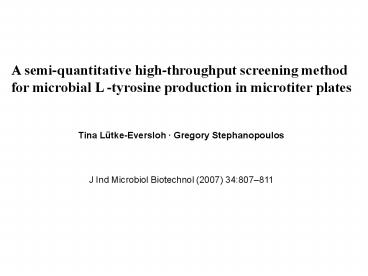A semiquantitative highthroughput screening method - PowerPoint PPT Presentation
1 / 16
Title:
A semiquantitative highthroughput screening method
Description:
A semi-quantitative high-throughput screening method. for microbial L -tyrosine ... number of samples to identify putative microbes with altered L- tyrosine production ... – PowerPoint PPT presentation
Number of Views:80
Avg rating:3.0/5.0
Title: A semiquantitative highthroughput screening method
1
A semi-quantitative high-throughput screening
method for microbial L -tyrosine production in
microtiter plates Tina Lütke-Eversloh Gregory
Stephanopoulos J Ind Microbiol Biotechnol
(2007) 34807811
2
Industrial and pharmaceutical compounds derived
from L-tyrosine
1. stimulate brain activity 2. control depression
anxiety
3. for PKU patients
Parkinsons disease
1. Adhesive coatings 2. Bio-cosmetics 3. health
nutrition products
1. UV absorbers 2. Drug carriers 3. Semiconductors
3
Biosynthetic Pathway for L-tyrosine
Appl Microbiol Biotechnol (2007) 77751762
4
Pathway of aromatic amino acid biosynthesis and
allosteric regulation by end products
Appl Environ Microbiol, Nov. 2005, p.
72247228 Appl Microbiol Biotechnol (2007)
75103110 Appl Microbiol Biotechnol (2007)
77751762
5
L-Tyrosine production
Strain Development
- 1. Alleviation of regulatory circuits
- 2. Over-expression of rate-
- controlling enzymes
- 3. Use of auxotrophic strains to
- reduce by-product formation
- 4. Increased supply of
- intracellular precursors
Appl Environ Microbiol, Nov. 2005, p.
72247228 Appl Microbiol Biotechnol (2007)
75103110 Appl Microbiol Biotechnol (2007)
77751762
6
L-Tyrosine production
Strain Development
1. Alleviation of regulatory circuits
- ? Tyr R
- fbr derivatives of
- DAHP synthase and
- Chorismate mutase /
- Prephanate dehydrogenase
Appl Environ Microbiol, Nov. 2005, p.
72247228 Appl Microbiol Biotechnol (2007)
75103110 Appl Microbiol Biotechnol (2007)
77751762
7
L-Tyrosine production
Strain Development
2. Over-expression of rate controlling
enzymes
- fbr derivatives of
- DAHP synthase and
- Chorismate mutase /
- Prephanate dehydrogenase
Appl Environ Microbiol, Nov. 2005, p.
72247228 Appl Microbiol Biotechnol (2007)
75103110 Appl Microbiol Biotechnol (2007)
77751762
8
L-Tyrosine production
Strain Development
3. Use of auxotrophic strains to reduce
by-product form
- Block Trp and Phe pathways
E.coli T1 3.8 g/l ?tyrR fbr-DAHP synthase
fbr-CM /PDH
Appl Environ Microbiol, Nov. 2005, p.
72247228 Appl Microbiol Biotechnol (2007)
75103110 Appl Microbiol Biotechnol (2007)
77751762
9
L-Tyrosine production
ppsA
tktA
Strain Development
4. Increased supply of intracellular
precursors
- Overexpress ppsA and tktA
E.coli T2 9.7 g/l ?tyrR fbr-DAHP synthase
fbr-CM /PDH Transketolase PEP synthase
Appl Environ Microbiol, Nov. 2005, p.
72247228 Appl Microbiol Biotechnol (2007)
75103110 Appl Microbiol Biotechnol (2007)
77751762
10
(No Transcript)
11
L-Tyrosine production
Strain Development
Appl Environ Microbiol, Nov. 2005, p. 72247228
12
E.coli T1
E.coli T2
Glucose (g/l)
Glucose (g/l)
Growth (OD600)
Growth (OD600)
Tyrosine (g/l)
Productivity
Productivity
Tyrosine (g/l)
Appl Environ Microbiol, Nov. 2005, p. 72247228
13
1Nitroso2-naphthol Assay
Charge transfer complex (red, unstable)
HNO2
HNO3
55oC for 1 hr
Remove excess dye with ethylene dichloride
Incubate at 25oC for 3 - 4 hrs
Fluorescence Exitation - 485 nm Emission - 590
nm
Stable yellow compound
Calorimetrically at 450 nm
CLIN.CHEM.29/11, 1969-1971 (1983) J Lab Clin Med
50733736, (1957)
14
(No Transcript)
15
High Throughput Screening Method
- Fluorescence based assay, employ 96 well
microtiter - plates
- Highly suitable for combinational approaches
- Sensitive (0.05 0.5 g/l) and rapid
- Doesnt require cell removal step by
centrifugation and - protein removal by TCA precipitation
J Ind Microbiol Biotechnol (2007) 34807811
16
Accuracy of the Nitrosonaphthol assay
J Ind Microbiol Biotechnol (2007) 34807811
17
Conclusion
The assay is suitable for screening large number
of samples to identify putative microbes with
altered L- tyrosine production
18
Thank You































